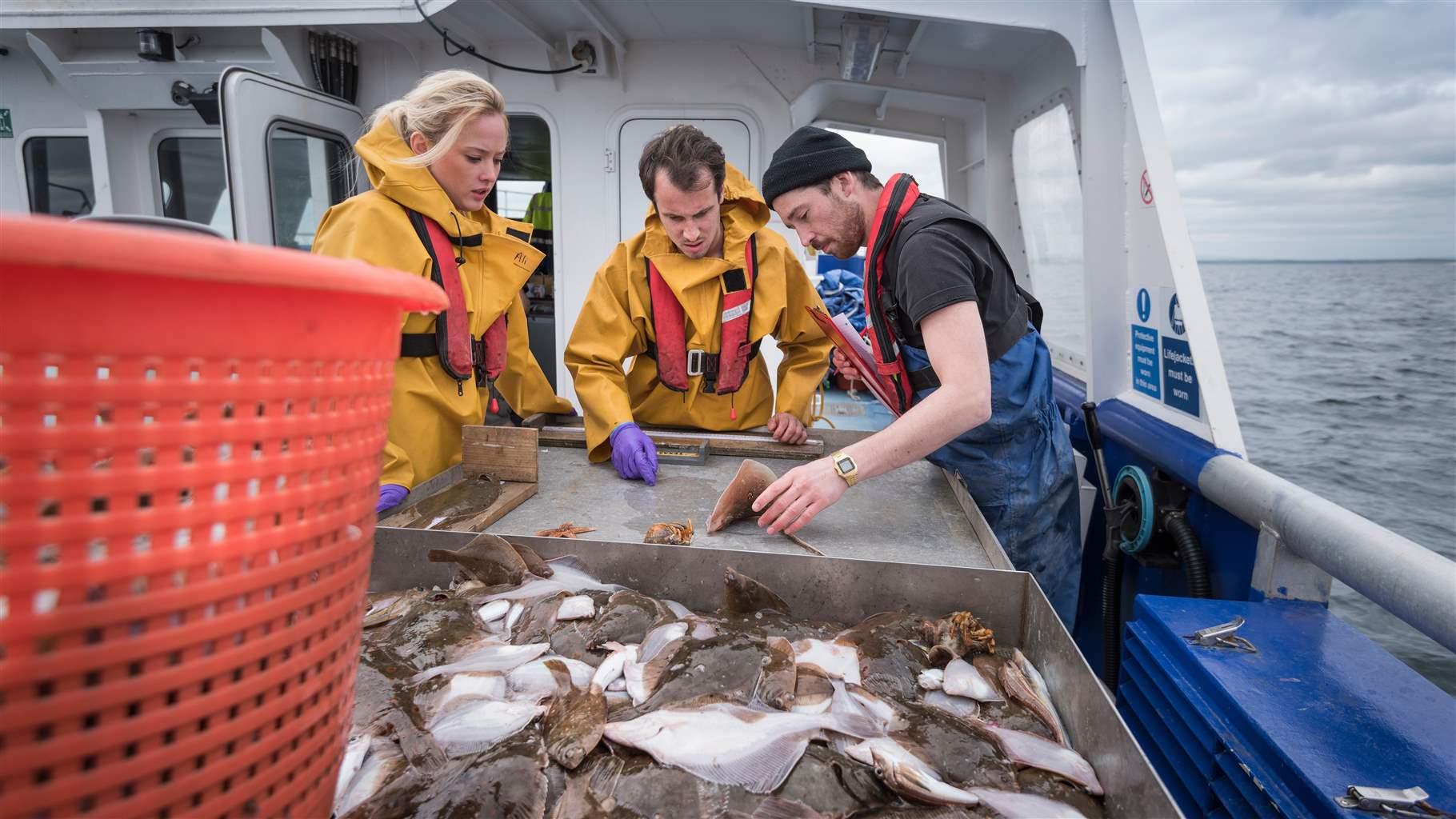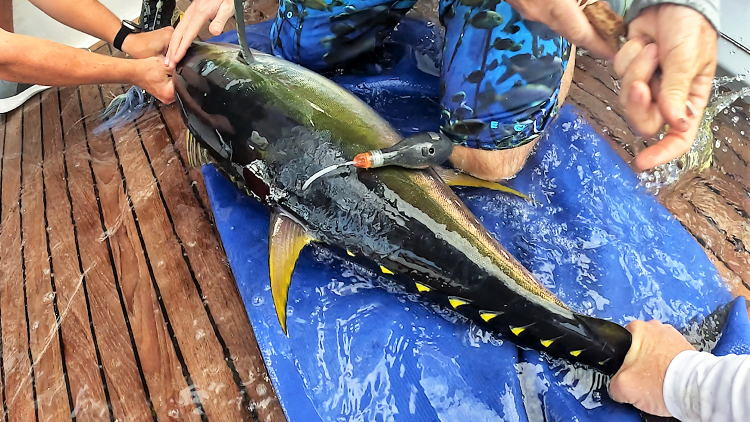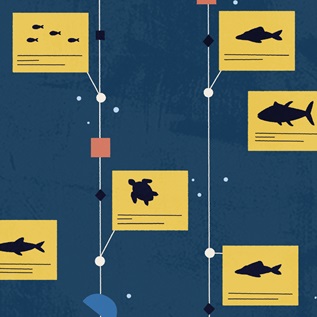To Improve Fisheries Management and Protect Ecosystems, Decision Makers Must Ask Better Questions
A checklist to help managers request scientific advice
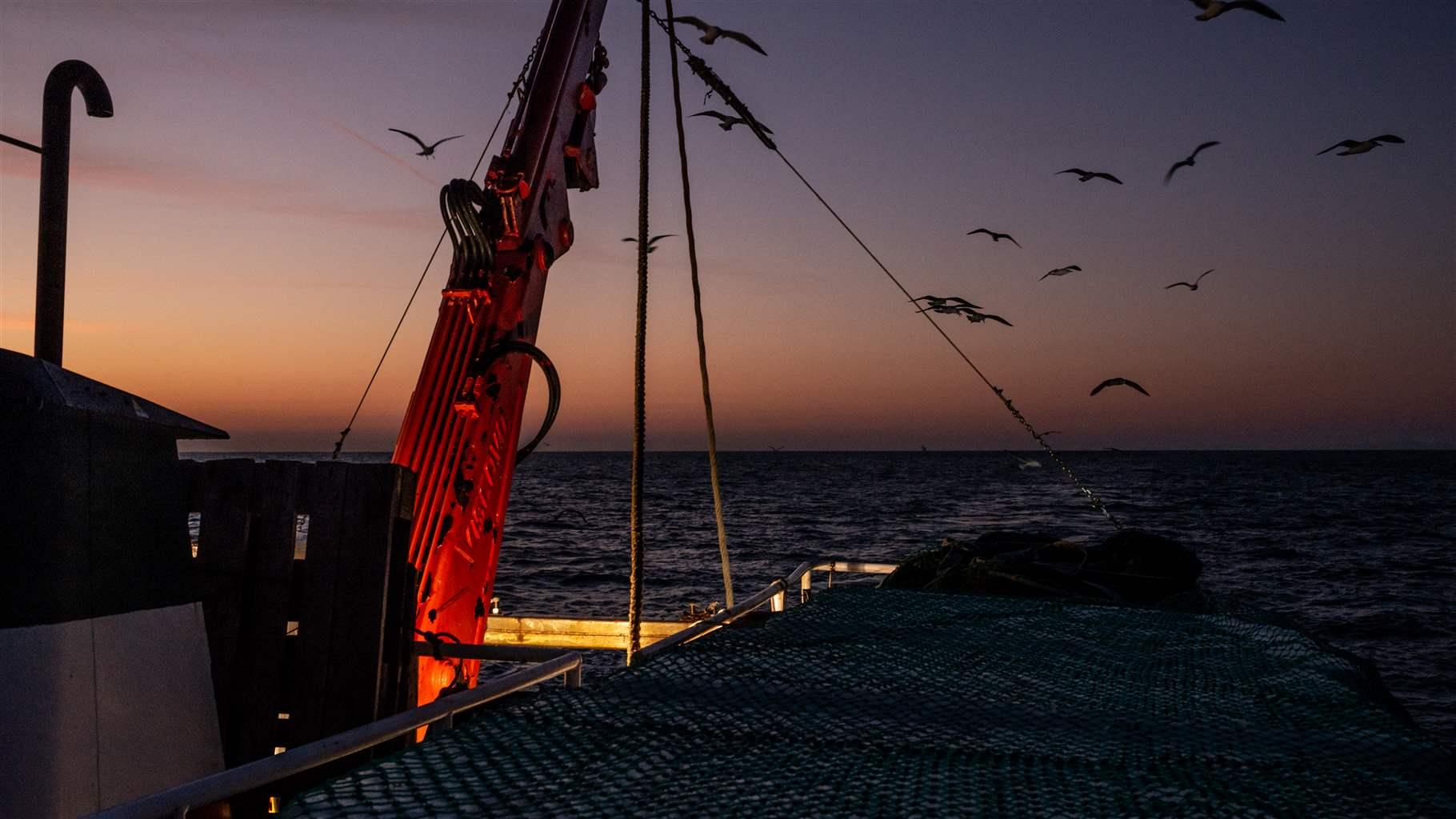
Overview
Good scientific advice is the fuel that drives the engine of fisheries management. When managers want to develop comprehensive, long-term policies for measures such as catch limits or gear restrictions, they pose questions related to their policy goals, which scientists then do their best to answer. And the more ambitious the question, the more far-reaching the advice.
Yet, managers have traditionally asked narrow questions that direct scientists to produce evidence focused only on individual fish populations and catches. And because scientific advice sets policy in motion, myopic questions tend to produce limited management that does not sufficiently address long-term ocean health and is out of step with the growing suite of international treaties, frameworks and other obligations.
With global treaties—such as the United Nations Fish Stocks Agreement (UNFSA), the Kunming-Montreal Global Biodiversity Framework (GBF) and the U.N. High Seas Treaty—compelling fisheries managers to adopt a broader ecosystem approach to the harvesting of marine wildlife and to move away from managing fisheries solely in terms of their yield, the need for more robust, expansive scientific advice has never been greater.1 Ecosystem-based fisheries management (EBFM) puts biodiversity at the centre of fisheries governance, requiring managers to consider interactions among species, such as how fishing of one species may deplete the food for another, and to dynamically adapt fishing practices in response to predicted or observed environmental changes. Satisfying these mandates will depend on scientific advice that addresses these larger considerations.
Fortunately, because managers initiate and control the scientific advice process—choosing the policy objectives, species, areas or fisheries requests will apply to, as well as the preferred level of confidence or risk—they have the power to improve it and the management practices it informs. Regional fisheries management organizations (RFMOs) and other multi-state fishery decision-making institutions often have dedicated capacity and the ability to draw on world-leading scientists to manage science advice processes and begin commissioning more comprehensive scientific guidance.
International fisheries managers should accelerate momentum towards EBFM by asking their scientific advisers ambitious, ecosystem-focused questions that consider multiple objectives across sustainable use and conservation policies. When seeking advice, they should set a broad scope that covers, for example, the population health of commercially targeted and non-commercially targeted species, habitat integrity and the relationships between oceanographic conditions and the distribution and abundance of target stocks.
This brief lays out three specific steps of effective advice requests—preparation, initiation and formulation—and provides an easy-to-use checklist that policymakers can follow to complete those steps, as well as five relevant case studies. Notably, managers who have not yet adopted an ecosystem approach can implement these steps right away both to develop more effective traditional advice requests and to better position themselves to receive the broader scientific guidance they will need as they move towards EBFM.
Preparation: Design the request process
To receive comprehensive scientific advice that can inform stronger management practices, requests to scientists must be crafted using a robust, transparent process that includes certain standard practices but also can be tailored to the specific context of each inquiry. This ensures that stakeholders are adequately involved and decisions are clearly documented. Key elements that should be part of every request process are:
- Lead forum: When developing a request process, managers should first identify—or if necessary, create— the entity that is best suited to initiate and oversee the request. Science-manager dialogue groups are ideal, although other bodies or agencies may also effectively perform this function.2 Further, requesting the scientific advice necessary to implement EBFM may require establishing complementary ecosystem-focused working groups or subsidiary committees in multilateral fisheries management bodies.3
- Open documentation: Once the lead forum has been designated, it should begin its work by establishing mechanisms, such as standardized templates and storage protocols, to fully record and transparently share with stakeholders all communications, meetings, and decisions relating to the request.
- Multilateral liaison: For shared international fisheries, an advice request necessitates support from and active involvement by all affected States. This is particularly critical in regions, such as the Northeast Atlantic, where various bilateral, trilateral, and multilateral/RFMO fisheries arrangements operating in the same ocean basin create an overlapping patchwork of governance regimes. In these instances, each request process should be jointly crafted and collectively reviewed by all relevant managers to reflect the domestic fisheries and environmental policies of all involved States.
- Stakeholder inclusion: The extent of stakeholder involvement should be customised for each request process. Fishing industry bodies, seafood supply chain companies, non-governmental organizations and other stakeholders can play a critical role in developing a request. Incorporating these and other diverse perspectives and forms of knowledge into the request formulation process improves the credibility, relevance and legitimacy of scientific advice and related policy decisions.4 For example, commissioning advice about an ecosystem or groups of species may require input from a broad range of stakeholders with lived experience of that ecosystem or expertise on specific species or broader ecological and social trends.
Importantly however, stakeholder inclusion should not be limited to the formulation of the request. Stakeholders may have differing visions and priorities for a fishery or ecosystem, and to ensure that their concerns are considered, the lead forum must devise transparent, coherent processes for how and when stakeholders provide input (ideally, multiple opportunities) and how their feedback is incorporated into the request and reconciled with policy obligations. Further, when a request process calls for complex models or simulations, the lead forum may need to engage stakeholders before those models are developed to ensure all affected groups understand the results and limitations.5
Initiation: Define the scope
Once a robust process has been devised, managers should begin developing the specific request by outlining the scope. The scope should reflect that increasingly, fisheries management contributes to a diverse set of global goals, which require actions that consider biodiversity conservation and societal targets and take an ecosystem— rather than a traditional single species, yield-based—approach.
- International and national obligations: Scientific advice is central to expanding fisheries management beyond mere yield-based approaches. So the scope of each request should detail all high-level commitments arising from relevant treaties, multilateral frameworks, conservation laws, sustainable use laws, and other political and legislative mandates to which managers expect the resulting advice will contribute. For example, is the scientific guidance intended to contribute to expanded or enhanced spatial protections, such as those outlined by the United Nations Convention on Biological Diversity’s Global Biodiversity Framework Target 3, or to preservation of target and non-target species, as laid out in Article 5 of the United Nations Fish Stocks Agreement.6
- Focal elements: The scope should stipulate all species, ecological groups and ecosystem considerations to be addressed in the scientific advice. Specificity and completeness can help ensure that scientists concentrate their research on these key elements and that managers do not misinterpret or ignore the advice. This is particularly important for requests that are intended to support an EBFM approach because focusing on only a single target species without reference, for example, to its predators, is likely to produce advice that is too narrow to support ecosystem-level decision-making.
Setting a comprehensive, detailed ecosystem scope may mean that requests seek advice on how to restore or maintain the populations of multiple species (including non-commercially targeted species) or how to preserve the health of marine habitats. An ecosystem scope requires expansive inquiries, such as asking scientists to analyse which management regime could best achieve an ecological goal across sea basins or to quantify the trade-offs between preserving habitat health and maintaining economically viable fisheries.7
Formulation: Draft terms of reference
The final stage in developing a request is to lay out the context, specific tasks and management expectations in a terms of reference (ToR) document. The ToR should clearly articulate the intent and policy impetus behind the request to help scientists develop useful advice, test a range of objectives (including trade-offs between them) and include the appropriate parameters and information.
- Objective setting: The most important step in drafting a request ToR is agreeing on which management objectives the advice will inform. These may derive from existing policies or frameworks, or they may be entirely new. Setting consensus-based objectives also is a key precursor to the achievement of EBFM in part because the set of possible desired outcomes in an ecosystem-based approach is far broader than in traditional management.8 For instance, whereas single-species management is guided by well-defined objectives, such as maximum sustainable yield—the largest catch that can be taken from a fish population over an indefinite period—EBFM frameworks, by contrast, tend to set less specific aims and allow managers to pursue intermediate benchmarks along the path to meeting those aims. Therefore, to request scientific advice that can effectively support EBFM, managers must define measurable objectives for testing, modelling and evaluation when developing a ToR.
- Objective measurement: To ensure that the ToR is sufficiently precise to yield EBFM-relevant advice, the lead forum should define the set of indicators, parameters and performance criteria against which scientists can judge management objectives. This may mean collaborating with scientific advisers to clarify which indicators should be evaluated, such as changes in potential catch levels to preserve predator consumption of prey species or how introduction of spatio-temporal measures might change fishing activity patterns.9 For well-established objectives and associated metrics, managers should state the values or ranges they need to achieve, such as maintaining a specific biomass of a stock or selecting fishing mortality reference points.
Testing ecosystem-level objectives and their indicators may require computer models that simulate future states or scenarios and compare various ecological and management conditions. With this in mind, managers should leverage the increasing use by scientists of ecosystem information and models with objective-testing tools such as management strategy evaluation (MSE)—a science-based decision-making framework that assesses the performance of a management plan under a range of scenarios—and specifically call for the use of such tools in the request ToR where appropriate.10 - Implementation plan: Managers should outline in the ToR how the advice will be used. Although policies or management actions can be fully designed only after advice is received, managers should nevertheless lay out—at least in broad terms—the actions they anticipate implementing and the conditions under which they would do so. This clarity will help build stakeholder support and enable later transparency regarding whether and how the request informed a management action.
Advice requesters checklist
These three steps for requesting scientific advice—preparation, initiation and formulation—can support international fisheries managers in making evidence-based decisions, demonstrating accountability to stakeholders and transitioning towards EBFM. And the following checklist (Figure 1) can help managers effectively implement the three steps as standard practice for scientific requests. The checklist is broadly applicable to any international fisheries management process. Importantly, despite being presented linearly, the checklist should not be understood as defining a rigid procedure. In practice, managers and stakeholders would undertake these actions in various orders or even simultaneously as their needs dictate.
In addition, Table 1 outlines five recent scientific advice request case studies and assesses them against the checklist. These examples include a unilateral request by the European Union and four requests from multilateral management bodies, three of which are RFMOs. Although none of the examples achieves full alignment with all checklist steps, the Ecosystem Approach Roadmap request by the Northwest Atlantic Fisheries Organization (NAFO) and the EU’s unilateral request on seabed habitats are the strongest, with both incorporating clear objectives and a broad scope. By contrast, the EU, Norway and UK request on herring satisfies the fewest checklist steps and includes minimal consideration of international obligations and limited opportunities for stakeholder input. The case studies demonstrate that flexibly applying the checklist can help managers maximise any request.
Although the checklist and case studies are of primary relevance to requests that explicitly support EBFM implementation, they are applicable to any scientific advice request. They also can help managers who still operate on a traditional model move towards greater consideration of ecosystem factors.
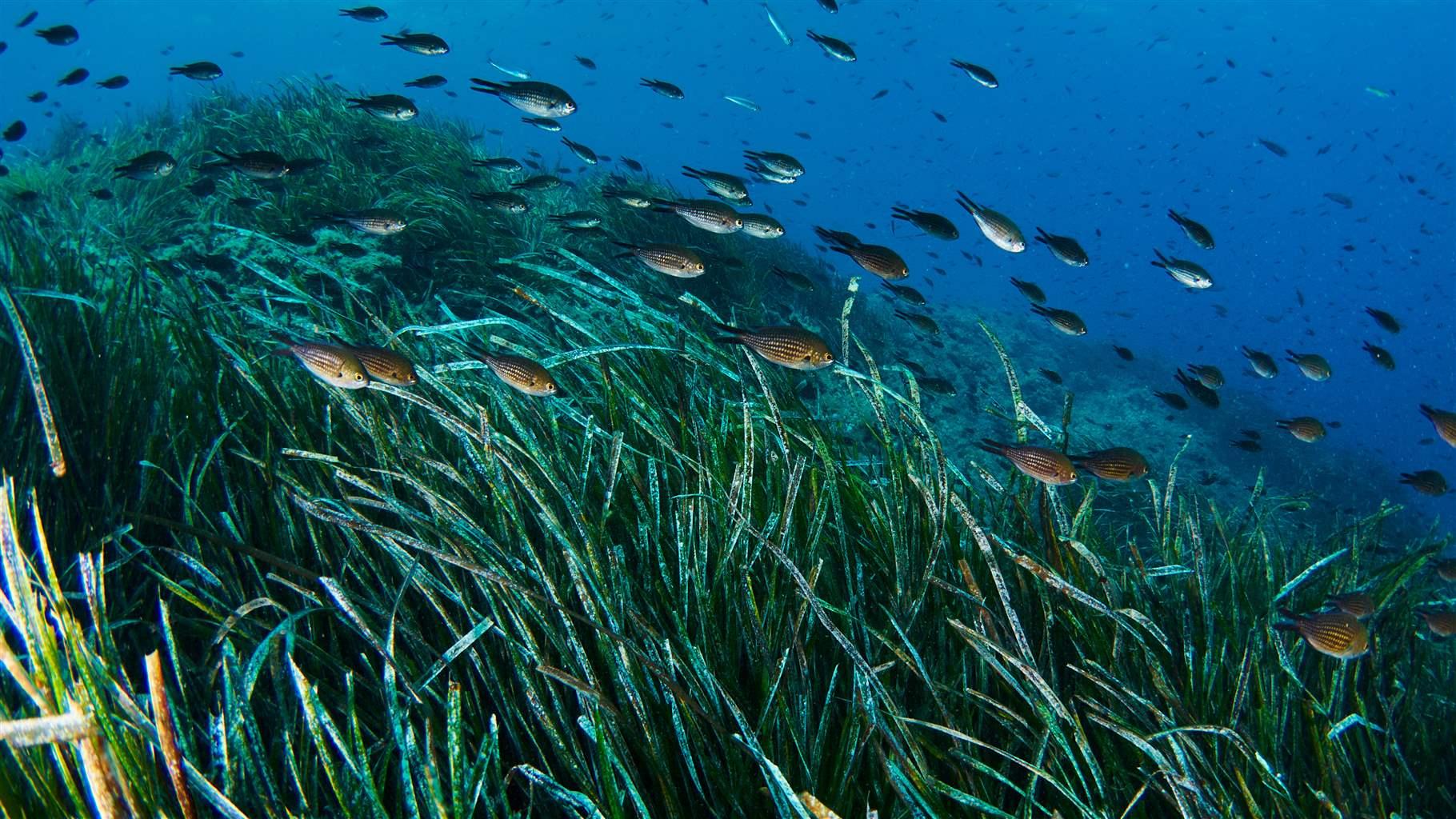
Figure 1
A Checklist for Requesting Ecosystem-Based Scientific Fisheries Advice
Key actions for preparing, initiating and formulating requests
Preparation: Design the request process
- Lead forum: Identify or create a relevant forum or mechanism to oversee request process, such as a science-manager dialogue group or ecosystem-focused advisory body.
- Open documentation: Develop a transparent system for recording and sharing the request process, including agreed templates and storage protocol.
- Multilateral liaison: Seek cross-state involvement in formulation of new requests for shared fisheries.
- Stakeholder inclusion: Design the request development process to include iterative, appropriate stakeholder input.
Initiation: Define the scope
- International and national obligations: Identify all treaties, laws and other agreements relating to fisheries, biodiversity and sustainable development with relevance to the request.
- Focal elements: Define what the request should examine, such as:
- A single species or stock.
- Multiple species within an ecological group.
- One or more eco-regions.
- One or more habitat types.
- A single fishery.
- Multiple fisheries (i.e., those that have similar ecosystem impacts or that interact).
Formulation: Draft the terms of reference
- Objective setting: Define policy aims or scenarios to be tested, modelled and evaluated, including ecological and socioeconomic objectives beyond those for target species.
- Objective measurement: Outline testable and acceptable indicators, thresholds and targets for both well-defined and novel objectives.
- Implementation plan: Outline how the advice will be used, including the conditions under which it will trigger a management action.
Table 1
Recent Science Advice Requests Show Benefit, Flexibility of Key Steps
Process for 5 requests, compared with checklist actions
| Individual party | Multilateral | Individual RFMOs | ||||
|---|---|---|---|---|---|---|
| Checklist stage | European Union (EU) 2016, 2017 and 2021 requests regarding interactions between demersal fisheries and seabed habitats | EU, United Kingdom and Norway 2022 request regarding draft long-term North Sea autumn spawning herring management plan | North-East Atlantic Fisheries Commission and Commission for the Convention for the Protection of the Marine Environment of the North-East Atlantic 2020 request regarding status and distribution of deep-water elasmobranchs | Western and Central Pacific Fisheries Commission (WCPFC) 2019 request regarding multi-species (mixed fishery) management for tropical tunas and South Pacific albacore | Northwest Atlantic Fisheries Organization (NAFO) 2008, 2009 and 2017 requests regarding roadmap for ecosystem approach to fisheries, total catch index | |
| Preparation | Lead forum | |||||
| Open documentation | ||||||
| Multilateral liaison | ||||||
| Stakeholder inclusion | ||||||
| Initiation | International and national obligations | |||||
| Focal elements | ||||||
| Formulation | Objective setting | |||||
| Objective measurement | ||||||
| Implementation plan | ||||||
| Sources: ICES, “EU Request for Guidance on How Pressure Maps of Fishing Intensity Contribute to an Assessment of the State of Seabed Habitats,” (2016); ICES, “EU Request on Indicators of the Pressure and Impact of Bottom-Contacting Fishing Gear on the Seabed, and of Trade-Offs in the Catch and the Value of Landings” (2017); ICES, “EU Request on How Management Scenarios to Reduce Mobile Bottom Fishing Disturbance on Seafloor Habitats Affects Fisheries Landing and Value” (2021); “Agreed Record of Fisheries Consultations Between the European Union, Norway and the United Kingdom” (2023); ICES, “NEAFC and OSPAR Joint Request on the Status and Distribution of Deep-Water Elasmobranchs” (2020); M. Koen-Alonso et al., “Review and Assessment of the Ecosystem Production Potential (EPP) Model Structure, Sensitivity, and Its Use for Fisheries Advice in NAFO” (2022); Scientific Committee of the Commission for the Conservation and Management of Highly Migratory Fish Stocks in the Western and Central Pacific Ocean, “Fifteenth Regular Session of the Scientific Committee” (The Commission for the Conservation and Management of Highly Migratory Fish Stocks in the Western and Central Pacific Ocean, 2019) |
Conclusion
Fisheries management depends on robust scientific advice, requested by informed decision makers who apply that advice when developing and delivering policy. Although this interplay of science and management is relatively well-established for single-species approaches, transitioning towards EBFM requires more expansive advice because managers are increasingly expected to achieve not only sustainable use but also conservationrelated goals.
To enhance the delivery of ecosystem-based scientific advice, managers should be more inclusive, ambitious, and specific in their requests. This means routinely including stakeholders in advice processes, formulating requests with a comprehensive scope and asking objective-driven, management-oriented questions. In regions that already have a strong scientific basis for ecosystem-based decision-making, more effective requests will help ensure that fishing is within safe ecological limits and is sustainable over time.
Endnotes
- The United Nations Fish Stocks Agreement (UNFSA) of 1995 provides the foundation for ecosystem-based fisheries management. More recently, the Kunming-Montreal Global Biodiversity Framework of 2022 and the U.N. High Seas Treaty both require fisheries managers to employ an ecosystem approach for all exploitation of wild species. See: Division for Ocean Affairs Law of the Sea, “United Nations Fish Stocks Agreement Overview,” United Nations, https://www.un.org/depts/los/convention_agreements/convention_overview_fish_stocks.htm; Convention on Biological Diversity, “Kunming-Montreal Global Biodiversity Framework” (2022), https://www.cbd.int/doc/c/e6d3/cd1d/daf663719a03902a9b116c34/cop-15-l-25-en.pdf; United Nations, “Agreement Under the United Nations Convention on the Law of the Sea on Conservation and Sustainable Use of Marine Biological Diversity Beyond National Jurisdiction” (2023), https://undocs.org/Home/Mobile?FinalSymbol=a%2Fconf.232%2F2023%2F4&Language=E&DeviceType=Desktop&LangRequested=False.
- The Pew Charitable Trusts, “To Strengthen Fishery Management, RFMOs Should Use Science-Management Dialogue Groups” (2022), https://www.pewtrusts.org/-/media/assets/2022/05/fisherymanagement_brief_v5.pdf.
- M. Koen-Alonso et al., “The Northwest Atlantic Fisheries Organization Roadmap for the Development and Implementation of an Ecosystem Approach to Fisheries: Structure, State of Development, and Challenges,” Marine Policy 100 (2019): 342-52, https://www.sciencedirect.com/science/article/pii/S0308597X18305694; M.J. Juan-Jordáet al., “A Template for an Indicator-Based Ecosystem Report Card for ICCAT” (International Commission for the Conservation of Atlantic Tunas, 2018), https://www.iccat.int/Documents/CVSP/CV074_2017/n_7/CV074073639.pdf; D. Agnew, “Review—the CCAMLR Ecosystem Monitoring Programme,” Antarctic Science 9, no. 3 (1997): 235-42, https://doi.org/10.1017/S095410209700031X.
- M. Ballesteros and M. Dickey-Collas, “Managing Participation Across Boundaries: A Typology for Stakeholder Engagement in the International Council for the Exploration of the Sea,” Marine Policy 147 (2023), https://doi.org/10.1016/j.marpol.2022.105389.
- D.R. Goethel et al., “Oceans of Plenty? Challenges, Advancements, and Future Directions for the Provision of Evidence-Based Fisheries Management Advice,” Reviews in Fish Biology and Fisheries 33 (2023): 375-410, https://doi.org/10.1007/s11160-022-09726-7.
- Convention on Biological Diversity, “Kunming-Montreal Global Biodiversity Framework”; Division for Ocean Affairs Law of the Sea, “United Nations Fish Stocks Agreement Overview.”
- J.W. Bentley et al., “Combining Scientific and Fishers’ Knowledge to Co-Create Indicators of Food Web Structure and Function,” ICES Journal of Marine Science 76, no. 7 (2019): 2218-34, https://doi.org/10.1093/icesjms/fsz121; ICES, “EU Request on Indicators of the Pressure and Impact of Bottom-Contacting Fishing Gear on the Seabed, and of Trade-Offs in the Catch and the Value of Landings” (2017), https://doi.org/10.17895/ices.advice.5657.
- R. Hilborn, “Future Directions in Ecosystem Based Fisheries Management: A Personal Perspective,” Fisheries Research 108, no. 2-3 (2011): 235-39, https://doi.org/10.1016/j.fishres.2010.12.030.
- Spatio-temporal measures could include, for example, seasonal restrictions on catching species, temporary or permanent closures of areas of particular ecological importance or other provisions to control catches of individuals of specific sizes.
- E.A. Fulton et al., “An Integrated Approach Is Needed for Ecosystem Based Fisheries Management: Insights From Ecosystem-Level Management Strategy Evaluation,” PLoS One 9, no. 1 (2014), https://journals.plos.org/plosone/article?id=10.1371/journal.pone.0084242; J.K. Craig and J.S. Link, “It Is Past Time to Use Ecosystem Models Tactically to Support Ecosystem-Based Fisheries Management: Case Studies Using Ecopath With Ecosim in an Operational Management Context,” Fish and Fisheries 24, no. 3 (2023): 381-406, https://onlinelibrary.wiley.com/doi/full/10.1111/faf.12733; M.G. Pennino et al., “New Approaches to Old Problems: How to Introduce Ecosystem Information Into Modern Fisheries Management Advice,” Hydrobiologia 850 (2023): 1251-60, https://doi.org/10.1007/s10750-02205083-5; M.A. Karp et al., “Increasing the Uptake of Multispecies Models in Fisheries Management,” ICES Journal of Marine Science 80, no. 2 (2023): 243-57, https://doi.org/10.1093/icesjms/fsad001; Q.C. Huynh, T. Carruthers, and N.G. Taylor, “Ecotest, a Proof of Concept for Evaluating Ecological Indicators in Multispecies Fisheries, With the Atlantic Longline Fishery Case Study,” ICCAT Collective Volume of Scientific Papers 79, no. 5 (2022): 165-77, https://www.bmis-bycatch.org/index.php/system/files/zotero_attachments/library_1/8H9WQ3ZL%20-%20Huynh%20et%20al.%20-%20ECOTEST%2C%20A%20PROOF%20OF%20CONCEPT%20FOR%20EVALUATING%20ECOLOGI.pdf.
